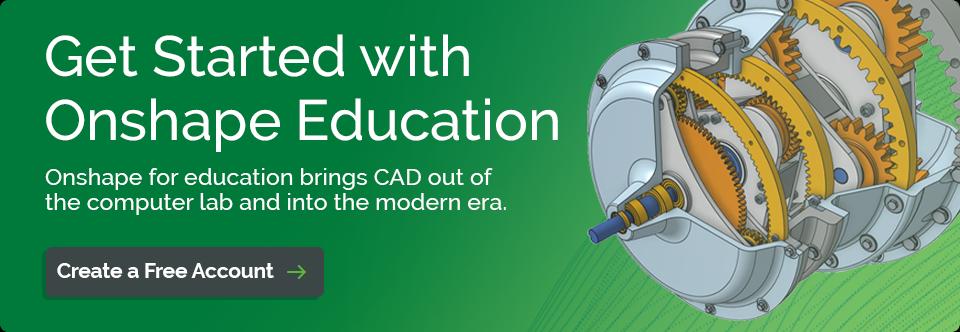
4:08
I remember back in the early 2000s when saving my schoolwork was a real hassle.
First, I had to navigate between two different word processors — the free software on my home PC and an old version of Microsoft Word at my high school computer lab. Then I had to figure out the best way to save my essays and presentations. A USB flash drive? Floppy disks? What if I used too many photos? Could the floppy disk handle the file size?
I can’t tell you how many times I lost my USB drive or broke flimsy floppy disks at the bottom of my backpack. And computer crashes frustrated students and educators alike.
Now in 2021 students can leverage the power of the cloud with tools like Google’s G Suite. But with certain software, the technology problems of the early 2000s still occur.
McKenzie Brunelle, Onshape Education Outreach Programs Coordinator, shared an example during a recent webinar, “How and Why to Make the Switch to Onshape for Your CAD Curriculum.”
“I was on the FIRST Robotics team when I was in high school,” she said. “We would have loved to use CAD to design our robot before we actually built it. Unfortunately, we just couldn't because our school gave us Macs, which couldn't run any CAD software. It was only a couple of students on the team that actually had the devices that could run CAD software. And so they would end up trying to design something and the rest of us were out of the loop.”
Brunelle’s story resonated with webinar viewers, who shared their biggest challenges while teaching CAD.
“Crashing” was the No. 1 response. Followed by not being able to use CAD on any device, the pain of grading, and lastly, the price tag.
Cloud-native CAD can solve these issues, and brings all the elements of a professional software into your classroom without all the baggage from file-based systems.
Here are four Onshape benefits for educators and students.
Cloud-Native CAD Expands Accessibility
“It's worth getting things onto the cloud,” Brunelle said. “With Onshape, it is really a huge difference for you and how you can run things at your school.”
To run cloud-native CAD, all that’s needed is an internet connection. That means students and teachers can access files wherever they are and on whichever device, including a Mac or a Chromebook, even tablets.
Beyond the physical aspect of accessing cloud-base software, there is the learning curve that comes with using new technology.
“The really great thing about Onshape is it is a lot more intuitive for someone who is just starting. The interface just feels like something students are used to,” Brunelle said. “Some desktop software and traditional CAD platforms look very old and out-of-date [to the students]. There's just so many buttons that are so intimidating, and it can be harder for students to get it.”
Instructing and Grading is Easier
It can be difficult to implement a lesson plan and give out assignments when files can’t be shared easily.
Onshape is able to hold different types of files within the platform. If there are instructions in a PDF file, or a video tutorial, students are able to access them in one place, an Onshape Document.
“Students could be looking at tutorials that you've developed, all in one place, because you can package everything together inside of an Onshape Document,” Brunelle said.
And because of Onshape's sharing and collaboration capabilities, an instructor is able to work with a student in real-time, allowing for clearer instructions and better support.
Find an Ever-Growing Library of Resources
Sometimes educators need inspiration for an interesting and engaging assignment. Or students need ideas for a project.
Onshape’s public Documents gives teachers and students a library of designs they can look through, make a copy, use a model for a new project, or just poke around to see how a design was made.
“There's some really awesome learning opportunities that are available by looking in the public space,” said Drew Bennett, Onshape Education Technical Services Engineer, who also hosted the webinar.
“Instead of having your students have to learn how to model a Lego brick every time, this is a great way for just giving them a quick starter model that they can learn Assembly or some other concept without having to take as much time learning all the modeling,” Brunelle said.
Preps Students for Their Future
Having a portfolio can be the difference between getting into a dream college or that new job.
And with Onshape, even after graduation, students can access their work, Brunelle said. “That's really great for anyone who wants to build a portfolio to show their employers once they get into the job search stage.”
Students can further prepare by taking the Onshape Certified Associate exam to show potential employers a level of proficiency.
Convincing enough? Learn more about Onshape for Education and get started on your revamped lesson plan now!

Latest Content

- Case Study
- Automotive & Transportation
Zero Crashes, Limitless Collaboration, One Connected Workflow With Cloud-Native Onshape
12.04.2025 learn more
- Blog
- Becoming an Expert
- Assemblies
- Simulation
Mastering Kinematics: A Deeper Dive into Onshape Assemblies, Mates, and Simulation
12.11.2025 learn more
- Blog
- Evaluating Onshape
- Learning Center
AI in CAD: How Onshape Makes Intelligence Part of Your Daily Workflow
12.10.2025 learn more
- Blog
- Evaluating Onshape
- Assemblies
- Drawings
- Features
- Parts
- Sketches
- Branching & Merging
- Release Management
- Documents
- Collaboration
Onshape Explained: 17 Features That Define Cloud-Native CAD
12.05.2025 learn more



